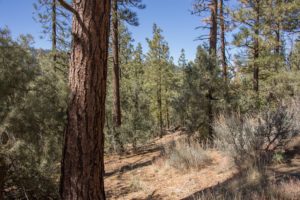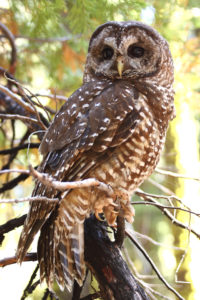Strix occidentalis occidentalis
- Proposed Endangered/Threatened – Endangered Species Act (2014)
- Sensitive – U.S. Forest Service
- Species of Special Concern – California Department of Fish and Wildlife
The spotted owl — the silent patriarch of old growth forests — has soared to fame as the focus of several major conservation battles across the West. In the early 1990s, the Northern spotted owl became embroiled in controversy as unsustainable logging practices collided with efforts to protect the owl’s dwindling old-growth habitat. Efforts to protect the owl’s southwestern cousin — the Mexican spotted owl — have also met with resistance. Both the Northern spotted owl and the Mexican spotted owl are listed as “threatened” under the federal Endangered Species Act.
The California spotted owl is the lesser-known cousin of the Northern and Mexican spotted owl, and is found in the Los Padres National Forest and other parts of California. The California spotted owl — known as “CSO” for short — is lighter brown in color and has larger white spots compared to its northern counterpart.
According to the Forest Service, “substantial threats” to the California spotted owl exist throughout southern California. However, the CSO is the only spotted owl that has not yet been placed on the threatened and endangered species list. In 2003 and again in 2006, the U.S. Fish & Wildlife Service refused to grant formal protections for CSO. The agency received two more detailed petitions to list the species as endangered in 2014 and 2015. In 2015, we submitted comments advocating for the listing of the CSO as endangered, and again federal officials refused to protect the owl. Following a lawsuit and more than two decades after scientists first sought protections for the owl, the federal government finally moved forward in 2023, proposing “endangered” status for CSO in southern and coastal California and “threatened” status in the Sierra Nevada.
Habitat
California spotted owls are found along the western slope of the Sierra Nevada, in the southern Coast Ranges from Monterey County to Santa Barbara County, and in the Traverse and Peninsular Ranges from southern California to Baja California. The owl resides in forest habitats at elevations of below 1,000 feet along the coast to as high as 8,500 feet inland.
California spotted owls can be found in four general forest types in Southern California: riparian-hardwood forest, live oak/bigcone Douglas-fir, mixed conifer forest, and redwood/California laurel forest. They require a multi-layered forest habitat with high canopy closure and a mixture of tree sizes and densities, as well as large diameter old-growth trees for nesting and roosting. CSOs are sensitive to high temperatures and during hot summer days move up or down within the canopy to regulate their body temperature.
California spotted owls have large home ranges spanning from 1,000 acres to nearly 9,000 acres. The Los Padres National Forest contains approximately 144 spotted owl territories, including 30 in southern Monterey County, 3 in the Cerro Alto area and 16 in the southern Santa Lucia Mountains in San Luis Obispo County. In Santa Barbara County, where spotted owl territories are more plentiful, there are 12 in the Sierra Madre Range, 40 in the San Rafael Mountains, and 18 in the Santa Ynez Mountains. In Ventura County, 15 spotted owl territories occur around Mt. Pinos, 10 in the San Emigdio Mountains, and 10 in the Cobblestone Mountain area.
Reproduction
California spotted owls are normally solitary creatures. They nest in natural tree cavities, broken treetops, or abandoned nests of other large birds in areas of dense old-growth forest. Spotted owls breed between February and August, and have a single brood of 1- 4 young per year. California spotted owlets (like the one shown in the photo below) are pure white in color and develop brown barring and overall color as they mature.
As is common with most owl species, there is a strict division of parental duties. The female owl incubates the eggs and, once they have hatched, cares for the young. The male owl spends a large amount of time foraging for food. The juveniles usually disperse from the nest between September and October. Interestingly, the same pair of breeding owls may use a specific nest site for 5-10 years before relocating, but they may not breed every year. The survival rate of young spotted owls is extremely low, but when they do survive to adulthood, they can live relatively long, up to 17 years.
Behavior
California spotted owls are nocturnal, sleeping during the day and active at night. They are most active two hours after sunset and before sunrise. In order to maintain comfortable body temperatures, these owls tend to roost higher in the forest canopy during the winter and lower in the summer. They will even switch roosting location throughout the day in response to temperature changes or exposure to direct sunlight!
California spotted owls may begin foraging as early as an hour before sunset. They are “perch and pounce” predators meaning they generally find a suitable foraging site, select a single perch and await prey to pounce on. They will rotate through several foraging sites each night. Important prey for the California spotted owl includes dusky footed woodrats, small mammals, birds, and insects.
Threats
The California spotted owl is listed as a Sensitive Species by the U.S. Forest Service and by the California Department of Fish and Game as a Species of Special Concern. Despite these designations, the CSO continues to decline in southern California due to stand-replacing wildfires, vegetation management activities, salvage logging, urban development, and several other uses and activities on the national forests. Intense, stand-replacing wildfires are considered the primary threat to California spotted owl habitat. Salvage logging, tree mortality (such as that caused by sudden oak death), and drought all pose threats to the species because they result in the loss of large old growth trees which provide California spotted owl habitat.
The recent surge in vegetation clearing projects could have a substantial effect on local CSO populations. The Forest Service estimates that up to 25% of primary spotted owl habitat would be affected by intensive fuel treatments, such as thinning, mastication, and fuel break construction. ForestWatch monitors vegetation removal projects on the Los Padres National Forest to ensure that any treatments in these areas do not harm the spotted owl or its habitat.

The Forest Service has approved a massive commercial logging project on Tecuya Ridge (pictured) within CSO habitat.
Because of their specific habitat preferences, spotted owls in southern California are very susceptible to fragmentation and populations are usually clustered in disconnected “islands” of suitable habitat surrounded by larger areas of unsuitable habitat. Human activity within spotted owl habitat can not only lead to direct habitat loss but also to noise disturbance, especially during the nesting season.
California spotted owls face competition from the invasive barred owl. This aggressive relative of the spotted owl has increased in numbers over the last decade and expanded its range further into spotted owl habitat — muscling California spotted owls out of their own territory.
ForestWatch is working to strengthen the standards and guidelines in the Los Padres National Forest plan to better protect California spotted owls and their habitat. The Forest Service has approved commercial logging on Tecuya Ridge near Mt. Pinos, including removal of large trees, both alive and dead, along a 12-mile swath. The project area is within feet of documented CSO observations, yet the Forest Service exempted the project from an environmental assessment. The Forest Service has also approved logging in spotted owl habitat on Pine Mountain, and has proposed tree removal for Mt. Pinos. A proposed tree and vegetation removal project across 235,000 acres of Los Padres National Forest also has the potential to significantly degrade CSO habitat. ForestWatch is working to ensure that these projects are modified or canceled to protect spotted owls and other wildlife that depend on healthy, mature and old-growth forests.
More Information
- Listen to the call of the spotted owl!
- Read the spotted owl’s species account.









